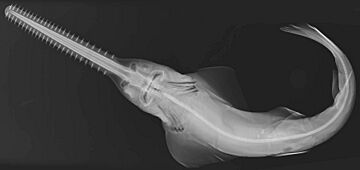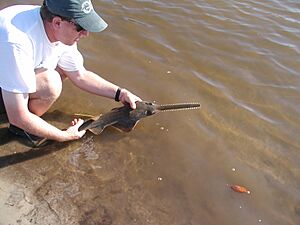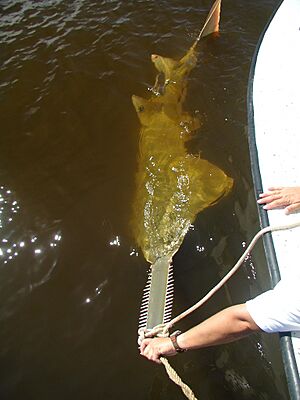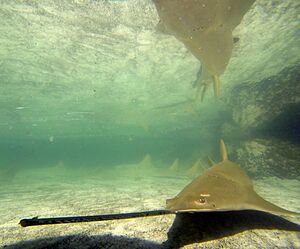Smalltooth sawfish facts for kids
Quick facts for kids Smalltooth sawfish |
|
|---|---|
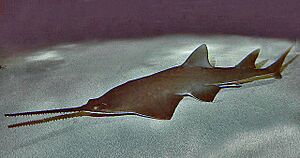 |
|
| Pristis pectinata at the Aquarium of the Americas | |
| Conservation status | |
| Scientific classification | |
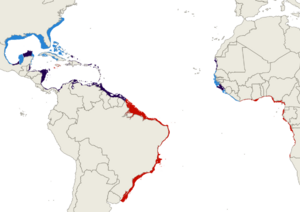 |
|
| IUCN range
Extant (resident) Possibly extinct Presence uncertain |
The smalltooth sawfish (Pristis pectinata) is a special type of sawfish. It belongs to the Pristidae family. You can find it in warm, shallow waters along the coasts and in river mouths of the Atlantic Ocean. Other sightings were likely different kinds of sawfish. Sadly, it is a critically endangered animal. It has disappeared from many places where it used to live.
Contents
Where Smalltooth Sawfish Live
The smalltooth sawfish lives in warm parts of the Atlantic Ocean. This includes the Caribbean and the Gulf of Mexico. Its original home was the smallest of all sawfish species. It covered about 2.1 million square kilometers (810,000 square miles).
In the west, it once lived from the United States down to Uruguay. In the east, it ranged from Senegal to Angola. Today, it is gone from much of this area. There are old stories of them in the Mediterranean Sea. But these were probably sawfish that wandered far from home. Experts now say they are gone from the Mediterranean Sea.
Their Favorite Homes
Smalltooth sawfish mostly live in coastal ocean waters. They also like estuarine areas where fresh and salt water mix. They prefer water less than 8 meters (26 feet) deep. But adult sawfish are sometimes seen deeper, up to 122 meters (400 feet).
Young sawfish have been found far up rivers when the water is saltier. These fish usually live in places with soft bottoms, like mud or sand. But they can also be found over rocky areas or near coral reefs. They often live where there are mangrove trees or seagrass beds. The water needs to be at least 16–18 degrees Celsius (61–64 degrees Fahrenheit) for them to live there.
What Smalltooth Sawfish Look Like

The smalltooth sawfish can grow very long. Some reports say up to 7.6 meters (25 feet), but this might be too high. The biggest confirmed size is 5.54 meters (18.2 feet). They can weigh up to 350 kilograms (770 pounds).
Their top side is brownish-gray, gray, bluish-gray, or blackish. Their belly is whitish.
How They Are Different
The smalltooth sawfish has some unique features. Unlike the largetooth sawfish, its main back fin is usually above its belly fins. It also has short side fins and almost no lower tail fin.
You can tell it apart from the dwarf sawfish and green sawfish because those two only live in the Indo-Pacific. The smalltooth sawfish has a narrow "saw" on its nose. This saw has 20 to 32 teeth on each side.
How the Saw Helps Them
For a long time, scientists did not know exactly how sawfish used their saw. This was because they were so rare to see in the wild. People thought the saw was used to either sense food or catch food, but not both. But new studies show that sawfish use their saw for both!
Finding and Catching Food
A sawfish's saw has thousands of special sensors. These sensors help them find other animals by feeling their electric fields. The sensors are thickest on the top of the saw. This helps the sawfish "see" the area above it, even in murky water. This is why they often stay close to the sea floor. They use their saw like an extended eye to sense everything around them.
Scientists used to think sawfish mainly ate crabs and clams from the sand. They thought the saw was used for digging. But recent studies looked at the DNA in sawfish poop. They found that most of their diet (71%) was fish! Crabs and clams were a small part (14%).
It is believed that the long saw first developed to help them catch food. Smalltooth sawfish have been seen swimming into large groups of fish. They swing their saw quickly from side to side. Because there are so many fish, the sawfish is likely to hit, stun, or kill several fish at once.
A scientist named Barbara Wueringer studied how sawfish use their saw. She watched them react to food on the tank bottom and food falling from above. When food was on the bottom, the sawfish used its saw to pin the food down. Then it swam over and ate it. When food fell, the sawfish would quickly strike it with its saw teeth. This shows they use their saw for both digging and attacking.
Wueringer also used electric signals to see if sawfish could sense prey. The sawfish reacted to these signals, either avoiding or approaching them. This proved that sawfish use their saw to sense their surroundings. The sawfish is now known as the only fish with jaws that uses its nose for both finding and catching food.
For Defense
The many "teeth" on a sawfish's saw are not real teeth. They are special scales called dermal denticles. These sharp weapons, combined with the sawfish's strong side-to-side swings, make a powerful defense.
While the saw is mainly for feeding, sawfish in aquariums have used it for self-defense. If sharks or other sea creatures bother them, sawfish will hit them three times with their saw. Sawfish are not dangerous to humans unless they feel threatened.
Smalltooth Sawfish Reproduction
Scientists have not studied the reproduction of smalltooth sawfish very much. This is despite them being critically endangered. But we can learn a lot from other similar fish called elasmobranchs.
In aquariums, sawfish have been seen doing "courtship biting." This is when males gently bite the female's side fins before mating. Male and female sawfish have slightly different numbers of teeth on their saws. The saw's sensors are also thought to help in finding a mate. Males use their sensors to find females, and females use them to find males.
Recently, scientists saw something amazing. Some smalltooth sawfish in Florida were born without a male parent. This is called parthenogenesis. About 3% of the sawfish in one area were born this way. Researchers think that because sawfish are so rare, females might not find a male. This could cause them to reproduce on their own.
Sawfish are ovoviviparous. This means their eggs hatch inside the mother. The young grow inside her without a special connection like a placenta. The baby sawfish get food from a yolk sac until they are born. A mother can have up to 20 babies at once. They likely reproduce every two years. After mating, the male and female go their separate ways.
Protecting Smalltooth Sawfish

Smalltooth sawfish are in great danger. They easily get caught in fishing nets. They also live in specific areas and do not have many babies. The IUCN Red List lists them as critically endangered.
The main reason they are endangered is fishing. They used to live in 47 countries. Now, they might be gone from 26 countries. Their presence is uncertain in 16 more. This leaves only 5 countries where they definitely still live. Some experts say they only survive in 19% of their original home.
The smalltooth sawfish is the only sawfish that still lives in the United States. The National Marine Fisheries Service listed them as endangered in 2003. It is thought that the U.S. population is now less than 5% of what it used to be. They once lived from Texas to New York. Today, they are mostly found in Florida. In the Everglades area of Florida, their numbers are now stable and might be slowly growing.
They also definitely live in the Bahamas, Cuba, Belize, Honduras, and Sierra Leone. It is not clear if they still live in the western Gulf of Mexico or off South America. This species is also protected by an international agreement called CITES.
A few smalltooth sawfish are kept in aquariums in North America. In 2014, there were 12 of them. A public aquarium in Colombia also has some. This is the only sawfish species that has successfully bred in captivity.
In early 2024, many sawfish in Florida started acting strangely. They were spinning or whirling. Scientists are trying to figure out why this is happening. They are also trying to rescue and help the sick fish.
See also
Images for kids



